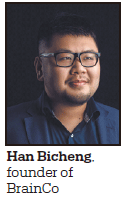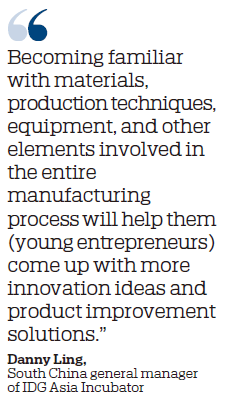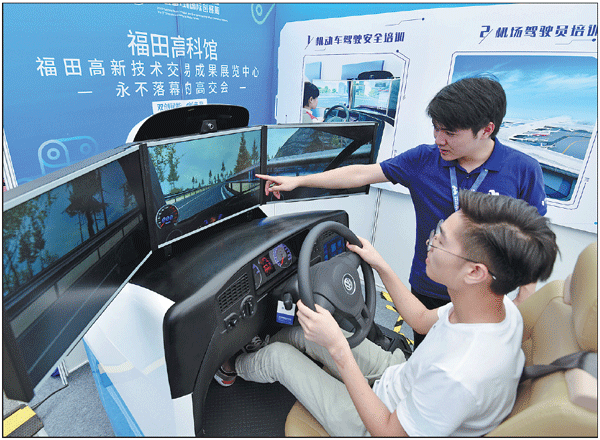Entrepreneurs acquiring practical skills
Young well-educated innovators are taking to the factory floor to find ways to merge tech research with manufacturing
Chu Yinghao, a 32-year-old entrepreneur, is one of the best educated welders in China.
He received his doctorate from the University of California, San Diego, and worked in a postdoctoral position at the San Diego Supercomputer Center. But now he spends his days in a storage rack factory, surrounded by raw materials and welded racks.
Sparks spew out around him and a smell of burning chemicals pervades the air as workers in blue uniforms and masks are busy welding.
Chu and two colleagues are working in a corner of the facility on a machine - a prototype of a robot arm that uses artificial intelligence technology to weld like a human.
The trio embodies a growing group of highly educated young entrepreneurs in China, who are conducting cutting-edge technological research and are equipped with down-to-earth manufacturing skills.

Through sheer hard work, they have become a valuable contributor to Shenzhen's scientific achievement transfer ability, which distinguishes the city as a global innovation center.
Meanwhile, their participation is supporting the upgrading of the region's manufacturing sector, as AI technology, sensors and new materials are replacing the consumption electronic terminals.
Chu co-founded the startup AIATOR in 2017 in Shenzhen. Before then, "I had never thought about learning welding, not to mention actually doing it," he said.
His team also looked into the bike-share and education industries, but now is concentrating on the manufacturing sector as he found "the largest value of AI technology" in the field.
The true value of innovation lies where the demand is the most practical, he said. In China, there are about 10 million welders and the job is injurious to their health in the long term, so many young people don't want to do it anymore.
The commercialization of AI products in the manufacturing industry is extremely hard. According to market intelligence provider IDC, the manufacturing industry only accounted for 9.5 percent of China's total AI market in 2018, while the top three are the government, internet and finance industries.
"Unfortunately, we failed to find any experienced welders who knew about AI, so we had to learn in order to connect the two," Chu said.
At the outset of developing AI technology for the industry, Chu spent about a month in a factory to learn from experienced welders. "They did not have the patience to teach us and just handed us some textbooks," he said.
He had to learn by watching the welders' movements. Now he is as familiar with welding jargon and techniques as he is with coding languages.
"Some welders' knowledge and skills are accumulated from experience and it is hard for them to describe. So we need to come to the site and try it with our own hands in order to learn and program our robots," he said, adding that this kind of information cannot be obtained from videos or photos.
"We can collect data in testing and training labs, but new factors and results always keep coming up when applying the algorithm in a real factory environment," he said.
"Once, we came up with about 400 solutions in a month and only two of them met demand," he added.
Han Bicheng, a PhD graduate of the Harvard Center for Brain Science and founder of BrainCo, said he also met with many technological problems that he had not anticipated before mass production.

He said his startup is one of the world's leading brain machine interface companies that focuses on developing brain sensing wearable devices in the education and wellness spaces, a technology new to most factories in China and even the world, so it requires "in-depth participation" for us in the whole production process.
For example, they found the workload to calibrate signal accuracy of their products was extremely labor intensive and time consuming because it required workers to try on all their headbands and the first batch was 20,000 units. To solve the problem, they spent six months creating a human brain simulation machine as a testing tool.
Another difficulty was finding the right manufacturing partner. The startup's requirement for accuracy is high as it is designed to detect the electricity generated by the surface of the human scalp, which is measured in microvolts.
"So we need to work with large factories that can meet our requirements and have an independent R&D team, but they usually are not willing to work with small startups who have a limited number of orders," he said.
We have to convince them with the industry's potential market, as it is a big investment for them to take on the risk of a novel technology and open a new production line, he said.
Chu said he found factory managers to be prudent, pragmatic and strict. "The elements they value most are cost, profit and quality control, but researchers and customers often choose a subject or product that interests them," he said.
Luckily for him, one of AIATOR's investors, Googol Technology, helped them find some of their manufacturing partners. Googol was also founded by highly educated entrepreneurs - a group of professors from Hong Kong University of Science and Technology - in 1999.

Googol is a bellwether of robot control systems, but it is also an incubator of China's intelligent manufacturing industry, opening a channel for new entrepreneurs to transform from scientific research in universities to industrialization. As one of Googol's investments, AIATOR can access the former's laboratory and collaborate on solutions for clients.
Googol's chairman Li Zexiang, who incubated Shenzhen-based drone-maker SZ DJI Technology Co Ltd, said at a forum in Dongguan in Guangdong province in June that one of the paramount routes to transform technological achievement is to incubate startups, but he admitted industrialization is more challenging than academic research and its success rate is also lower.
The firm has set up several research centers and industrial parks in China including Chongqing, Zhengzhou in Henan province, and Dongguan in Guangdong province to incubate hardware startups. These platforms serve to connect universities, factories and markets, and cultivate academic entrepreneurs.
Li believes linking industrial development and academic research is the key to building an international technology center.
In the blueprint of the Guangdong-Hong Kong-Macao Greater Bay Area released by the central government in February, one of the region's aims is to develop into a national demonstration zone for the transfer and commercial application of technological achievements.
"Becoming familiar with materials, production techniques, equipment, and other elements involved in the entire manufacturing process will help them come up with more innovation ideas and product improvement solutions," said Danny Ling, South China general manager of IDG Asia Incubator.
He also said some young entrepreneurs pay too much attention to business models and marketing in the process of commercializing a scientific idea, rather than the manufacturing process and product itself.
When coaching early-stage startups, he also suggests a team should have someone familiar with the production line and market at the executive level.
While exploring successful production solutions, these doctors in factories have retained their passion for scientific breakthroughs. Han said his startup's R&D investment is increasing by 10 times and Chu has also started to study new AI algorithms in more welding scenarios.
grace@chinadailyhk.com
|
A visitor experiences smart-driving technology during an international innovation fair in Shenzhen on June 13. Provided to China Daily |
(China Daily Global 10/10/2019 page9)



















